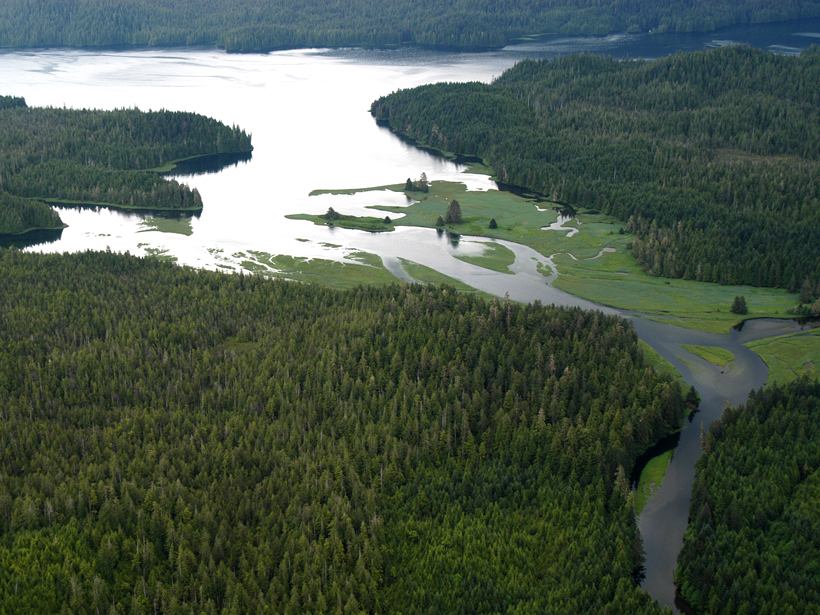Coastal margins are dynamic zones at the interface between land and ocean, where freshwater and nutrients flow downstream from coastal watersheds into the nearshore marine environment and where anadromous fish, many species of seabirds, and semiaquatic animals return marine-derived nutrients to the land. Quantifying this flux of materials is imperative to understanding linkages between terrestrial and marine environments, but it is often neglected in discipline-specific research.

The temperate rain forest of the northeastern Pacific, stretching from Alaska to northern California, is a particularly useful model system for understanding material flux. Abundant rainfall and snowmelt transport nutrients from the carbon-dense forests and peatlands of this region to the ocean via a distributed network of thousands of steep, small streams. These material contributions to the ocean may play a critical role in supporting productive marine food webs, abundant salmon runs, and a variety of fisheries.
Aquatic biogeochemistry was the subject of the first Coastal Rainforest Margins Research Network workshop. Thirty-five participants from the United States and Canada took part in 2.5 days of plenary talks, group discussions, and focused work sessions. Attendees included researchers from academia, the nonprofit sector, First Nations and Alaska Native organizations, provincial governments, and federal agencies.
Workshop discussions centered on modeling hydrologic and carbon fluxes for the Pacific coastal temperate rain forest region.
Workshop discussions centered on modeling hydrologic and carbon fluxes for the Pacific coastal temperate rain forest region, with the ultimate goal of developing a data-driven regional flux model for water and carbon. Participants split into five working groups that focused on hydrology, forest and soil ecology, dissolved and particulate organic carbon flux, dissolved inorganic carbon flux, and nearshore marine ecology. The groups discussed data collection methods, model building, and how best to link field and modeling efforts among disciplines and subregions.
The working groups identified several major data needs, which include the following:
- a seamless hydrology layer that incorporates the cryosphere and the hydrosphere (e.g., glacier mass balance and accurate precipitation models)
- scale-appropriate soil maps to use in hydrological routing and biochemical flux models
- multispecies carbon models for freshwater, including dissolved organic, dissolved inorganic, and particulate carbon
- a stronger understanding of the freshwater-marine interface, specifically a region-wide estuary classification based on watershed type and connection to ocean
The immense but distributed delivery of minimally processed carbon to nearshore marine ecosystems may be underappreciated in the global carbon cycle.
Attendees agreed that the immense but distributed delivery of minimally processed carbon to nearshore marine ecosystems is the defining feature of this and other similar coastal rain forest ecosystems, which may be underappreciated in the global carbon cycle. Workshop participants debated the relative significance of each carbon component in these fluxes (e.g., particulate, organic, inorganic), and they agreed that to better understand nearshore carbon flux, evaluations will be needed across time and spatial scales.
Meeting participants resolved to initiate a specific effort to quantify the fluxes of carbon to coastal systems and to present a conceptual framework for the importance of the Pacific coastal temperate rain forest in regional- and global-scale carbon cycling.
The next Coastal Rainforest Margins Research Network workshop will focus on nearshore marine ecosystem processes, carbon integration into food webs, and nearshore ocean chemistry. It is scheduled for February 2018 in Vancouver, B.C., Canada. More details about the network and its workshops can be found on its website.
This project is funded by a grant (1557186) from the National Science Foundation and is supported by the Hakai Institute, the Alaska Coastal Rainforest Center at the University of Alaska Southeast, and the University of Washington Freshwater Initiative.
—Allison Bidlack (email: [email protected]), Alaska Coastal Rainforest Center, University of Alaska Southeast, Juneau; Brian Buma, Department of Environmental Sciences, University of Alaska Southeast, Juneau; and David Butman, School of Environmental and Forest Sciences and Department of Civil and Environmental Engineering, University of Washington, Seattle
Citation:
Bidlack, A.,Buma, B., and Butman, D. (2017), Quantifying coastal rain forest carbon transport, Eos, 98, https://doi.org/10.1029/2017EO077633. Published on 19 July 2017.
Text © 2017. The authors. CC BY-NC-ND 3.0
Except where otherwise noted, images are subject to copyright. Any reuse without express permission from the copyright owner is prohibited.

